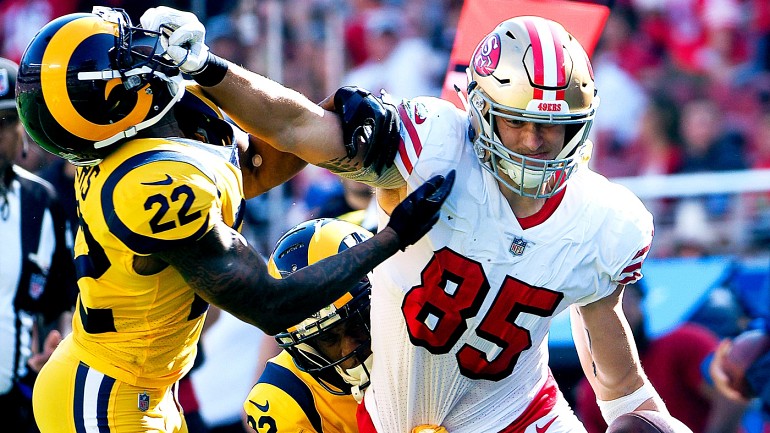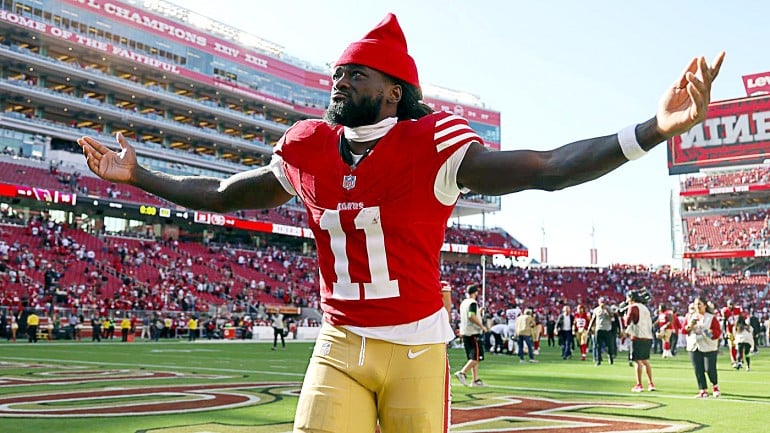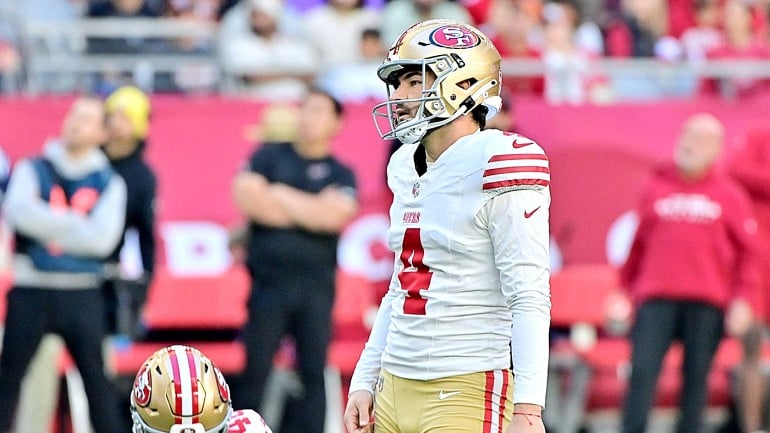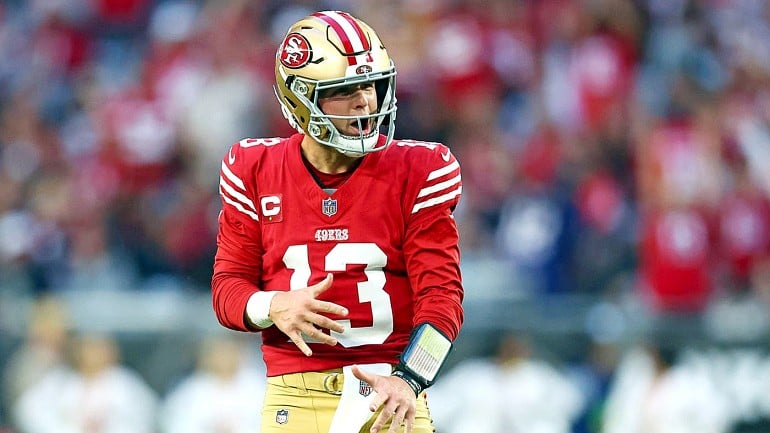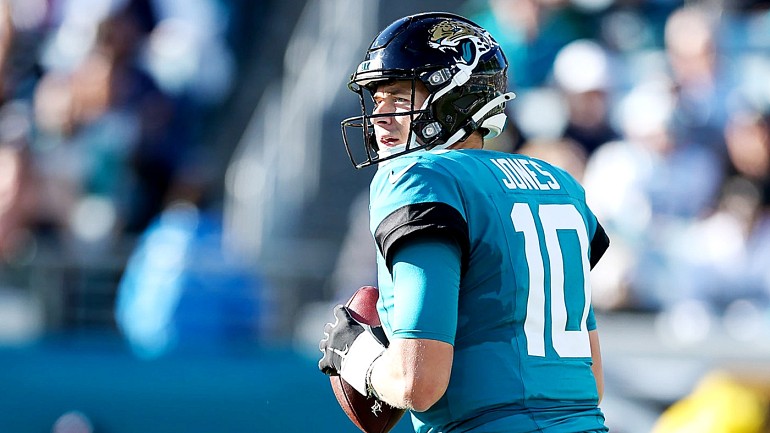Hot take alert: George Kittle is having a break out year and is one of the best tight ends in the league, maybe even the best. He's currently the seventh ranked run blocker among tight ends and the fifth ranked receiving tight end per Pro Football Focus' grades. He's already surpassed his rookie season totals in receiving yards, touchdowns, and yards per game.
The underrated aspect of Kittle's game is his ability to run block, a skill set that doesn't necessarily show up in game day broadcasts due to the camera angle and the nature of the audience to follow the ball carrier rather than individual blocking assignments. While many of the second year players on the 49ers roster are experiencing sophomore slumps, it is Kittle who has elevated the play of the offensive line and running game beyond Shanahan's brilliant play calling.
While some of the league's best tight ends in receiving aren't necessarily good run blockers, in Kittle, Shanahan has found someone to whom he can anchor the running game in addition to being a receiving threat. It is in the running game however, that we're going to see how and where he makes his impact most felt.
OUTSIDE ZONE BACK SIDE AND PLAY SIDE BLOCKING
While Shanahan is known for running a variety of blocking schemes, he primarily runs the wide zone or outside zone as it's more commonly referred to because of its ability to laterally stretch a defense. Kittle's vital role in the offense shows up week after week and makes it difficult to prepare for.
On the outside zone, the two most important areas the offensive line must block and maintain those blocks are the front side of the play where the running back needs to make his cut reads and the backside of the play to keep defenders from chasing down a running back who's waiting for the blocking to develop. Shanahan does a good job week after week of disguising where the point of attack on any given running play is going to hit.
On this outside zone, the play goes to the offense's left but Kittle (No. 85) is the in line tight end to the right, making him responsible for that back side edge defender. Kittle is responsible for a "reach" block against the Chargers' Chris Landrum (No. 46) and preventing him from chasing down running back Alfred Morris (No. 46). Kittle scoops and reaches Landrum and gets locked in a battle that Kittle ultimately wins as he eventually pancakes Landrum into the grass as Morris reaches his cut lane and gets up field.
It's not just on the backside of the outside zone where Kittle makes his presence felt either. Shanahan will frequently use Kittle on the front side of any given running play to create space for his running backs.
Later in the same game against the Chargers, Kittle sets the edge against one of the better edge defenders in the NFL in Melvin Ingram (No. 54). This time Kittle lines up on the play side of the formation to the offense's left next to right tackle Garry Gilliam (No. 76), who is in for the injured Joe Staley. The two are going to combo block Ingram before Kittle eventually takes him one-on-one. As Gilliam provides a little extra help to Kittle as the snap goes, Kittle kicks out Ingram and drives him toward the sideline to create a lane for the running back. Kittle does an excellent job of getting his hips and shoulders opened up and driving through the defender.
Ingram eventually sheds Kittle and makes the play, however, because the running back was forced to bounce outside of Kittle due to the alley defender in the gap to Kittle's right.
ABILITY TO CREATE RUNNING LANES
There are other times where the running play isn't successful but it isn't because of Kittle. Kittle starts out on the left of the formation and goes on a "Y-trade" motion to the right side, indicating to quarterback C.J. Beathard the defense is in man coverage. Cardinals safety Budda Baker (No. 36) follows Kittle to the opposite side, indicating that's who Kittle is responsible for. Poor Budda.
The play is revealed to be a fullback lead zone with Kittle kicking the edge defender out of the box and opening a lane for fullback Kyle Juszczyk to lead block through. The Cardinals get good penetration, however, and stuff the run at the line of scrimmage. Kittle does his part, though, and locks up with Baker and drives him into the turf just down and to the left on the screen.
Kittle would make another pancake block in this game on safety Antoine Bethea (No. 41).
Later on the goal line in the same game, Kittle would again create space with his incredible blocking technique. The 49ers are running the pin-and-pull toss play that utilizes Kittle's elite athleticism in space to take on and kick out the edge-setting defenders. The pin-and-pull is a blocking scheme that creates easier-to-reach blocks for offensive lineman.
Since Kittle is coming from an offset wing position, he wouldn't be as capable of reaching the down lineman in the D-gap. Garrett Celek (No. 88) and Kittle will instead switch responsibilities as Celek will "pin" the defensive end to the inside as Kittle pulls around to the edge to kick out Antoine Beathea. Kittle's block kicks out Beathea (No. 41) but Morris never cuts between Juszczyk and Kittle and the Cardinals clog up yet another run.
Kittle, however, shows perfect execution again by sinking his hips and creating what LeCharles Bentley calls "positive torso lean" where the shoulders, hips, and knees are in line and horizontal as he is engaging Bethea at the point of attack. This enables him to drive through the defender as he stays square.
SECOND LEVEL BLOCKS
The diversity of Shanahan's run game also highlights another aspect of Kittle's skill set: his ability to get to the second level in the run game and make key blocks.
The 49ers are running a counter trey with Kittle as the back side tight end and Laken Tomlinson (No. 75), who both pull to the play side and lead Morris through the point of attack. Shanahan uses fly motion to get the defense to widen away from the play side and hesitate in their read of the play just long enough to allow the blocks to form.
Kittle is responsible for linebacker Haason Reddick (No. 43). As Morris takes the handoff, Kittle beats him easily to the point of attack and leads him through the hole. He locates Reddick, who scrapes over the top into the running lane with eyes on the fly motion and is in position to make a play on Morris. Kittle comes through the hole into the second level and drives Reddick out of the way for Morris.
Kittle can also do it from the play side and makes two key blocks on the edge of the Cardinals defense at the line of scrimmage and then up at the second level. The play call is another fullback lead wide zone.
Kittle comes across the formation again in a "Y-trade" motion and lines up on the offense's left side. This time he'll be engaged in a "trey scoop" block (tackle-tight end combo block) on the defensive end before reaching the second level defender to seal off the edge. Kittle engages the double team and moves on after Staley engages the block. The offensive line seals the edge to the interior and Kittle reaches the second level linebacker with ease to create a running lane for Morris.
Unfortunately the play was called back due to a holding penalty on a receiver.
Another variant of the zone running play is the split zone that utilizes a "sift" blocker from the back side to seal off the edge and create a potential running lane. Shanahan again incorporates the fly motion to get the defense to hesitate and react to it. Juszczyk is the sift blocker on this play kicking out the defensive end while Kittle's responsibility is the weak side linebacker in the second level.
The fly motion gets the linebacker to widen into Kittle's blocking range where Kittle engages Packers linebacker Antonio Morrison (No. 44) with a wide base driving through his heels into Morrison with that torso lean described above. Morrison would be in prime position to make a tackle from the second level on running back Raheem Mostert but Kittle drives through and locks him up, driving him out of the play and pancaking him off the screen.
This level of physical violence to drive through a defender with near perfect technique and mechanics is nothing short of remarkable for a second year player.
A play we have seen occasionally in Shanahan's playbook the last two years is the zone read. The Cardinals are no stranger to seeing the zone read since it's been a feature of NFC West offenses since Colin Kaepernick and Russell Wilson started running it in 2012. The Cardinals have more than enough experience to flush it out when they see it. It also helps if the quarterback makes the wrong read, like Beathard did here.
Kittle is on the play side with responsibility to block Baker in the second level. In the zone read, the edge offensive player lets the defensive end get a free rush so that the quarterback can make the read to either hand off or keep. Kittle drives Baker into the dirt with his ability to stay square and keep his power position in front of him. Beathard sees the end barely crash and decides to keep the ball.
The Cardinals have the play defended well as they execute a scrape-exchange with linebacker Josh Bynes (No. 57) and Bethea, who both force Beathard to the outside for a gain of zero. Had they been able to block Bethea out on the edge, Beathard would have had a clear running lane behind Kittle who knocked out his only would-be tackler.
It's clear that Kittle is an anchor in the running whom Shanahan relies on to make key blocks to spring the running back free. Kittle's blocking skill set is rivaled by his athletic ability in the passing game as a receiver both in-line and split out wide. In the next part of this two-part series, we'll look how Shanahan uses Kittle in the passing game.
All gifs and images courtesy of the NFL.
All statistics courtesy of Pro Football Reference unless otherwise stated.
